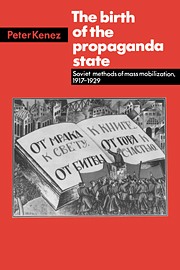Book contents
- Frontmatter
- Contents
- List of illustrations
- Preface
- Introduction: The Soviet concept of propaganda
- Part I The Civil War
- Part II The new economic policies
- 6 Political education
- 7 The literacy campaign
- 8 The Komsomol in the 1920s
- 9 The golden age of the Soviet cinema
- 10 The press and book publishing in the 1920s
- Conclusion and epilogue
- Notes
- Glossary
- Bibliography
- Index
9 - The golden age of the Soviet cinema
Published online by Cambridge University Press: 02 December 2009
- Frontmatter
- Contents
- List of illustrations
- Preface
- Introduction: The Soviet concept of propaganda
- Part I The Civil War
- Part II The new economic policies
- 6 Political education
- 7 The literacy campaign
- 8 The Komsomol in the 1920s
- 9 The golden age of the Soviet cinema
- 10 The press and book publishing in the 1920s
- Conclusion and epilogue
- Notes
- Glossary
- Bibliography
- Index
Summary
The Western European public quickly came to appreciate the great Soviet filmmakers of the silent era. The film, and of course especially the silent film, is an international medium, and therefore the works of Vertov, Pudovkin, Dovzhenko, and above all Eisenstein attracted the interest of contemporaries. As time went on this interest not only did not decline but increased; an ever larger segment of Western opinion came to regard cinema as a major form of art and a medium that had a special significance in shaping the twentieth-century mind. The film and the study of film became fashionable, and in the mushrooming film histories the great Soviet figures usually received their due.
The communist ideology of the artists and the fact that they served the Soviet regime did not at all harm their reputation. Indeed, in the 1930s and once again since the 1960s the adjective “revolutionary” had a positive connotation among Western intellectuals. They looked on the Soviet directors as creators of the “revolutionary cinema.”
Revolutionary cinema is an ambiguous phrase; different people at different times have attributed different meanings to it. Often it refers to innovative filmmaking. Eisenstein and his colleagues, of course, made great contributions to the development of the special language of the cinema and therefore they were revolutionary in this sense, but so are all other great artists at all times and everywhere.
In a trivial sense revolutionary cinema means nothing more than choosing revolutions as subject matter. Soviet directors in the 1920s often selected their topics from the history of the revolutionary movement, and, naturally, invariably depicted revolutionaries in a favorable light.
- Type
- Chapter
- Information
- The Birth of the Propaganda StateSoviet Methods of Mass Mobilization, 1917-1929, pp. 195 - 223Publisher: Cambridge University PressPrint publication year: 1985



